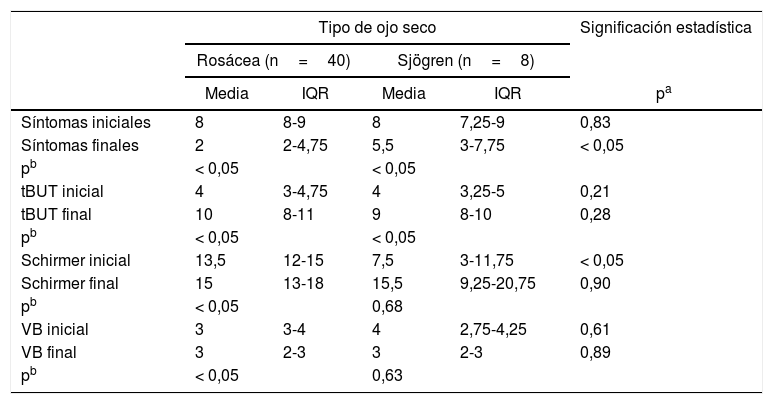Presentar los resultados del tratamiento con luz pulsada regulada (IPL) en pacientes con ojo seco.
Material y métodosEstudio retrospectivo. Se analizaron historias clínicas de pacientes con ojo seco sometidos a terapia IPL en quienes no se logró un control satisfactorio de los síntomas luego de terapia médica. Se evaluó previo al inicio y al final de la terapia una escala analógica visual de síntomas y además el tiempo de rotura de la película lagrimal (tBUT), test de Schirmer y puntuación de Van Bijsterveld. Se realizó un análisis de medidas repetidas con SPSS comparando los resultados antes y después de realizar la terapia IPL.
ResultadosSe analizaron 50 ojos de 25 pacientes: 9 hombres (36%) y 16 mujeres (64%); se encontró una mediana de edad de 59años (RIC 52-64). La mediana en la escala de síntomas fue de 8 (RIC 8-9) y 3 (RIC 2-4) antes y después del tratamiento con IPL (p<0,05). El tBUT tuvo una mediana de 4 (RIC 3-5) y 10 (RIC 8-11), el test de Schirmer de 13 (RIC 12-15) y 15 (RIC 13-20) y la puntuación de Van Bijsterveld de 3 (RIC 3-4) y 2 (RIC 2-3) antes y después del tratamiento, respectivamente (p<0,05 en todos los análisis).
ConclusionesLa terapia de IPL para el ojo seco es una excelente opción de tratamiento: muestra mejoría objetiva mediante la estabilización de la película lagrimal y tinción de superficie ocular, así como también mejoría subjetiva evidenciada en los síntomas manifestados por los pacientes.
To propose the Intense Pulsed Light (IPL) therapy as a helpful supplementary treatment in patients with dry eye disease.
Material and methodsRetrospective cross sectional design. Medical records of patients in whom dry eye disease symptoms were not satisfactorily controlled with medical therapy alone and who underwent additional IPL with at least three sessions completed. Data were analyzed before therapy and 3weeks after its completion to asses improvement. Determination of symptoms, through a visual analog scale; tear film stability, through tear Break Up Time (tBUT); measurement of tear secretion, through Schirmer Test; and ocular surface staining with Van Bijsterveld score were evaluated. SPSS software and nonparametric analysis of repeated measures were used. The study was approved by the ethics committee.
Results50 eyes from 25 subjects were reviewed. There were 9 males (36%) and 16 females (64%), with a median age of 59years (IQR 52-64). The median of the symptoms scale was 8 (IQR 8-9) and 3 (IQR 2-4) before and after the therapy respectively (P<.05). The median of BUT was 4 (IQR 3-5) and 10 (IQR 8-11), Schirmer test was 13 (IQR 12-15) and 15 (IQR 13-20), and Van Bijsterveld score was 3 (RIC 3-4) and 2 (IQR 2-3) before and after the therapy respectively (P<.05, for all measurements).
ConclusionIPL treatment has excellent results regarding both: dry eye disease symptoms improvement and in office objective tests such as tBUT, Schirmer test and Van Bijsterveld score; IPL could be considered as an effective adjunct for dry eye disease.
Artículo
Comprando el artículo el PDF del mismo podrá ser descargado
Precio 19,34 €
Comprar ahora







